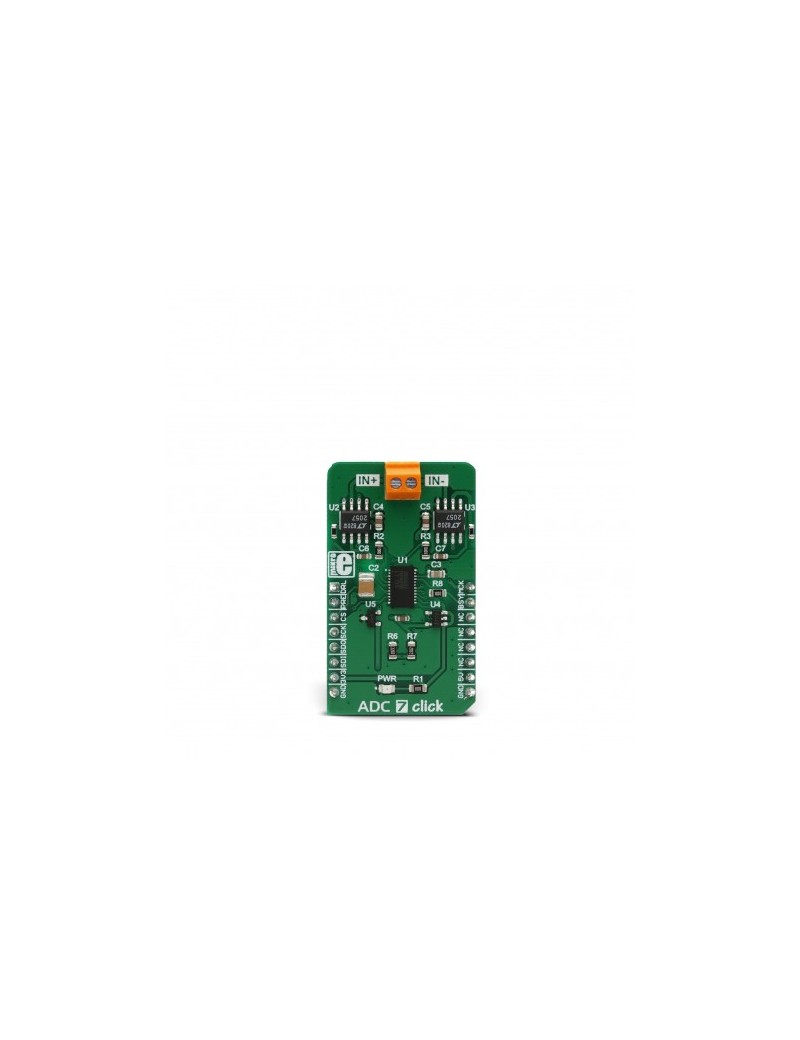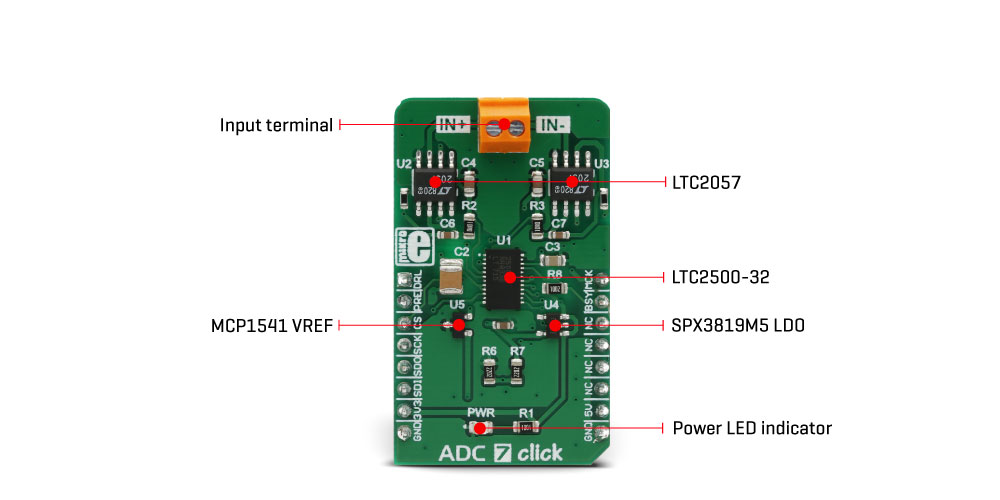

No products in the cart.


ADC 7 Click is an advanced 32-bit analog to digital converter (ADC) which uses the LTC2500CDKD-32, a 32-bit oversampling SAR ADC with a configurable digital filter. The filter provides several presets (selectable via the hardware pin), as well as programming of the filtering parameters, via the industry-standard SPI interface. The LTC2500CDKD-32 has some very good specifications: a very low noise on the output, a high dynamic range of 148dB at 61 SPS (samples per second), 32-bit output with no missing codes, and more. An integrated filter allows relaxed anti-aliasing filter requirements for the analog input signal, which simplifies the design.
A high dynamic range of this click allows it to be used for very precise sampling of the input voltage between A+ and A-, as it allows detection of changes down to a magnitude of few nanovolts. ADC 7 click accepts a differential voltage on the input terminal, which results in a robust and clean signal path. All these features allow this device to be used for developing various applications, including seismology applications, high precision instrumentation applications, energy exploration applications, and similar sensitive applications that require very high sampling accuracy.
ADC 7 Click uses the advanced ADC IC, labeled as LTC2500CDKD-32. It is a 32-bit oversampling ADC with a configurable digital filter, from Analog Devices. The integrated configurable filter is used to process the data from the 32bit successive approximation register (SAR) core, providing a very low noise on the output, with the high dynamic range up to 148dB. It also simplifies the design, as it relaxes anti-aliasing filter requirements for the input signal. The LTC2500CDKD-32 ADC also allows external reference voltage to be used, therefore the Click board™ provides it with 4.096 V from a tiny fixed reference voltage IC from Microchip, labeled as MCP1541.
There is a two-pole screw terminal on the Click board™, with its inputs routed to +IN and -IN pins of the ADC IC. The input signal can be bipolar, unipolar, and differential, swinging from 0 to VREF. Inputs are buffered with two LTC2057 operational amplifiers. These low-noise op-amps are used to adjust the impedance of the input, as the LTC2500CDKD-32 ADC performs optimally when driven with low impedance sources. The inputs are DC coupled - no decoupling capacitors are used on the input signal path.
The LTC2500CDKD-32 has two SDO pins available (dual SPI interface), yet only SDOA pin is used on this Click board™, offering conversion data from the programmable digital filter. To initiate the SPI communication, RDLA pin should be set to a LOW logic level. It is routed to the CS pin of the mikroBUS™, while the SDOA pin is routed to the MISO pin of the mikroBUS™, labeled as SDO. Configured like this, it is possible to use the standard four-pin SPI interface of the mikroBUS™ to communicate with the Click board™.
The digital filter can be either programmed via the SPI interface (SDI pin of the mikroBUS™), or it can use the PRE pin of the ADC IC. When the PRE pin is set to a HIGH logic level, a logic state on the SDI pin will be used to select one of two filter presets. Otherwise, when the PRE pin is set to a LOW logic level, the filter can be configured via the SPI interface. PRE pin is routed to the RST pin of the mikroBUS™ and labeled as PRE.
| Type | ADC |
| Applications | It can be used for developing various applications, including seismology applications, high precision instrumentation applications, energy exploration applications, and similar sensitive applications that require very high sampling accuracy |
| On-board modules | LTC2500CDKD-32 - 32-bit oversampling ADC with a configurable digital filter, from Analog Devices; LTC2057, a high voltage, low noise, zero-drift operational amplifier, from Analog Devices |
| Key Features | Seven types of integrated digital filters with programmable options, 32-bit data output with high dynamic range, wide range of common mode voltage allows different kinds of bipolar and unipolar input signals to be sampled, and more |
| Interface | SPI |
| Feature | No ClickID |
| Compatibility | mikroBUS™ |
| Click board size | M (42.9 x 25.4 mm) |
| Input Voltage | 3.3V,5V |
This table shows how the pinout on ADC 7 click corresponds to the pinout on the mikroBUS™ socket (the latter shown in the two middle columns).
| Label | Name | Default | Description |
|---|---|---|---|
| PWR | PWR | - | Power LED indicator |
| TB1 | IN+, IN- | - | Input signal connection terminal |
We provide a library for the ADC 7 Click as well as a demo application (example), developed using MIKROE compilers. The demo can run on all the main MIKROE development boards.
Package can be downloaded/installed directly from NECTO Studio Package Manager (recommended), downloaded from our LibStock™ or found on MIKROE github account.
Library Description
This library contains API for ADC 7 Click driver.
Key functions
Function performs the device configuration by sending configuration data .
Function generates clock signal on MCK pin and on that way starts conversion.
Function reads voltage value from AD converter and calculates this value to mV.
This Click board™ is supported with mikroSDK - MIKROE Software Development Kit. To ensure proper operation of mikroSDK compliant Click board™ demo applications, mikroSDK should be downloaded from the LibStock and installed for the compiler you are using.
For more information about mikroSDK, visit the official page.